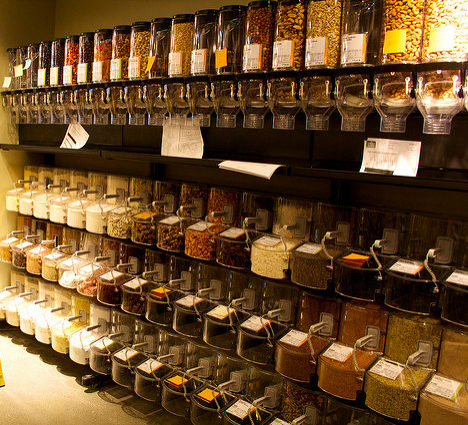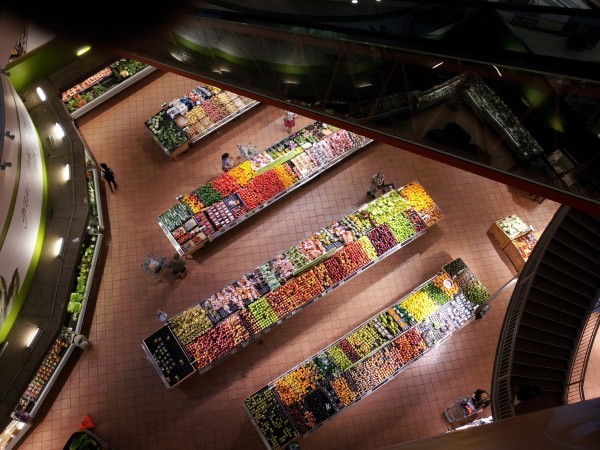Before we dive into grocery shopping, lets erase the mindset that you’re a “starving” artist. Both literally and figuratively this idea doesn’t serve you. If that’s the mentality then you’re living in a place of lack and that’s not going to support a vibrant life. So think about ways you can support yourself and create an “abundant” life. That doesn’t require excessive resources but it might take some rethinking of the way you’re using what’s available to you.
Depending on where you’re dancing and living your situation with wages is going to vary. From an overall budgeting standpoint it’s important to look at what you’re paying for rent, what your fixed expenses are each month, how much you’re saving and then how much you’d like to spend on groceries.
When I lived alone I’d spend about $50-$60 a week on groceries.
Whether you think that’s a lot or a little, there are ways to save that everyone could employ.

Shop bulk – find a grocery store with a bulk section (ie bins of loose dry goods – you scoop out what you need) and buy things like oats, nuts, seeds, trail mix, lentils, rice, and other shelf – stable goods in bulk. The price is usually much less than a pre packed item and if you bring your own containers (which you’ll have to get ok’d by the grocery store first) you’ll be doing the environment a favor as well.
Use online services like Thrive Market to stock your pantry. This is a good alternative if you don’t have a store with a good bulk section. On Thrive Market they have discounted dry goods available for members after you pay a yearly membership fee. Maybe ask for the membership as a gift! Isn’t healthy food the best gift?
Shop produce that’s in season. In season, local produce tends to be less expensive since it’s abundant. It will also be higher quality since it didn’t travel 1000’s of miles over seas to get to you. If you can find a farmers market or farm share nearby that is usually more cost effective as well.
When you want a specific produce item that’s not in season see if it’s available in the freezer section. Flash frozen, organic produce is more cost effective and sometimes even more nutrient packed than far traveling produce. This is a tricky tip because honestly some produce tastes pretty gross after it’s frozen. I’ve found that blanching frozen produce then straining it or roasted in the oven are the best ways to prepare frozen veggies.
Avoid waste by featuring your produce front and center in your refrigerator. Without fail, when I ask my clients where they keep their fruits and vegetables the vegetables are often hidden away in drawers. In this case, “Out of sight, out of mind” is totally relevant. When fresh veggies are the first thing you see when you open your refrigerator you’ll be 1000% more likely to use them before they go bad.
I don’t know about you but when I have to throw out produce I feel like I’m literally throwing money in the trash can. Avoid it by ensuring that you’re eating all the good stuff before it’s no good.
Buy the store brand. Most grocery stores have their own in house brand that’s significantly cheaper than name brand. Now, keep in mind if there’s a smaller company that you like to support with your dollar than maybe pay a bit more to support small business 😉
Don’t buy the things you can make yourself : granola, granola bars, energy balls, hummus, desserts, etc. can be made not only more healthfully but also for less money if you make them at home. Obviously the initial investment in ingredients might be more money but once your pantry is stocked you’ll be set.
Which brings me to stocking your pantry. It’s one of those things that can take an initial investment of time and money but afterwards you’re going to have an easier time creating intriguing and healthy meals for yourself.

Pay attention to the different components going into each meal. If you make a batch of soup and the total cost of ingredients to make the soup is $10 but then it provides 5 meals over the week than it’s only $2 per serving. Compare that with eating a bunch of packaged snacks when sometimes a single granola bar costs $2 try to find the ways to make your eating as cost effective as possible.
There are cost differences between various protein sources. Meat and fish sources, especially high quality animal proteins, tent to be more expensive than animal protein sources. Things like lentils, beans, or tempeh go a long way and cost very little per serving. With animal proteins you need to be more aware of the way the meat was raised and what it was fed which can drive up the cost.
Some animal sources proteins that are less expensive include canned Tuna. I like this one from Thrive Market because it’s tested to have the lowest Mercury levels of any brand (that tends to be the concern with eating fish – oceans are unfortunately contaminated thus leading to contamination of the fish with things like Mercury).
Food is your fuel. What you put into your body is going to fuel your dancing, change your energy levels, and protect you against injury and disease. It’s vitally important that you make the best choices possible. So definitely keep that in mind when you’re doing your monthly budgeting.
Your grocery bill is an investment in your health. Try not to look at it as an area to skimp or go for the bargain if the food is lesser quality. Instead, get creative! Do some research and look for healthy, cost – effective recipes. Some of my favorites include oatmeal, avocado toast, smoothies made with frozen fruit, veggie chili, soups, quinoa or brown rice bowls, and soba noodle bowls.
How do you save when you grocery shop? Have any tips or ideas I missed? Share below! I’d love to hear what’s working for you and how you prioritize health without breaking the bank!
Photo credit: mattymatt on VisualHunt / CC BY-SA
